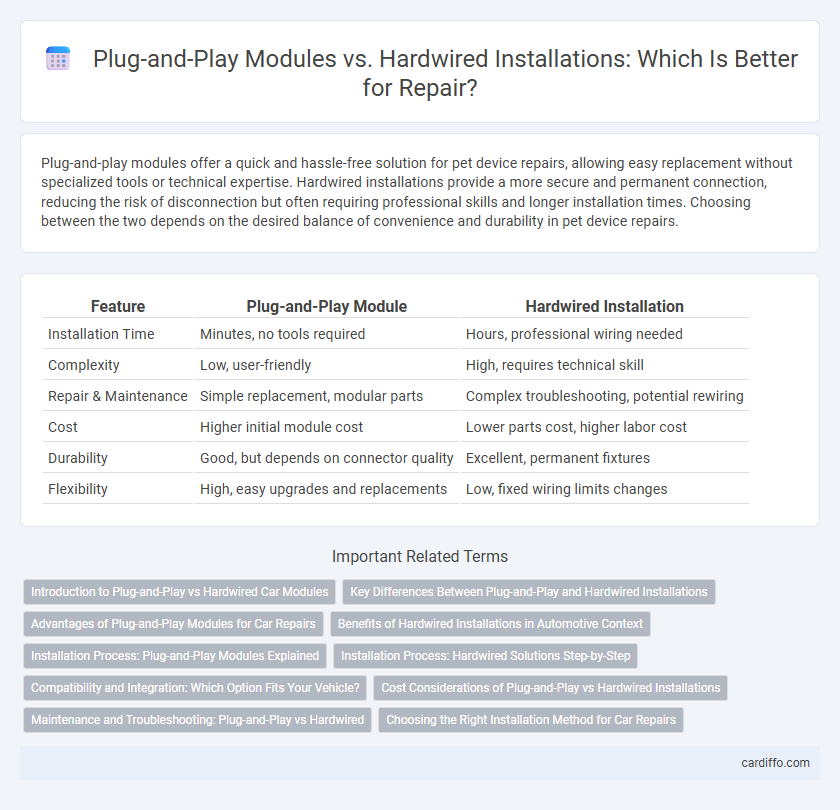Plug-and-play modules offer a quick and hassle-free solution for pet device repairs, allowing easy replacement without specialized tools or technical expertise. Hardwired installations provide a more secure and permanent connection, reducing the risk of disconnection but often requiring professional skills and longer installation times. Choosing between the two depends on the desired balance of convenience and durability in pet device repairs.
Table of Comparison
| Feature | Plug-and-Play Module | Hardwired Installation |
|---|---|---|
| Installation Time | Minutes, no tools required | Hours, professional wiring needed |
| Complexity | Low, user-friendly | High, requires technical skill |
| Repair & Maintenance | Simple replacement, modular parts | Complex troubleshooting, potential rewiring |
| Cost | Higher initial module cost | Lower parts cost, higher labor cost |
| Durability | Good, but depends on connector quality | Excellent, permanent fixtures |
| Flexibility | High, easy upgrades and replacements | Low, fixed wiring limits changes |
Introduction to Plug-and-Play vs Hardwired Car Modules
Plug-and-play car modules offer a streamlined repair solution by allowing direct connection without complex wiring, significantly reducing installation time compared to hardwired modules. Hardwired installations require manual integration into the vehicle's electrical system, providing a customizable but labor-intensive setup. Choosing plug-and-play enhances efficiency and minimizes error risk, making it ideal for quick repairs and upgrades.
Key Differences Between Plug-and-Play and Hardwired Installations
Plug-and-play modules offer quick, tool-free installation by simply connecting components through standardized ports, minimizing downtime and errors. Hardwired installations require direct wiring of each component, providing a more secure and stable connection suitable for complex or permanent setups. The key differences include installation complexity, flexibility, and ease of maintenance, with plug-and-play prioritizing convenience and hardwired focusing on reliability.
Advantages of Plug-and-Play Modules for Car Repairs
Plug-and-play modules streamline car repairs by enabling quick installation without extensive wiring or technical expertise, significantly reducing labor time and costs. These modules minimize the risk of installation errors, enhancing reliability and vehicle safety through standardized connectors. Compatibility with existing vehicle systems ensures seamless integration and immediate functionality, facilitating faster diagnostics and maintenance.
Benefits of Hardwired Installations in Automotive Context
Hardwired installations in automotive repair offer superior reliability and durability compared to plug-and-play modules, enabling consistent power delivery and reduced risk of loose connections in harsh driving conditions. They provide enhanced integration with a vehicle's existing electrical system, allowing for customized configurations tailored to specific performance requirements. This direct wiring approach also improves fault tolerance and simplifies troubleshooting by ensuring solid, permanent connections that minimize electrical interference.
Installation Process: Plug-and-Play Modules Explained
Plug-and-play modules simplify the installation process by allowing devices to be connected directly without extensive wiring or configuration, significantly reducing setup time. Unlike hardwired installations that require complex connections and specialized tools, plug-and-play systems rely on pre-configured connectors compatible with standard ports. This approach enhances repair efficiency, minimizes errors, and facilitates easier upgrades or replacements in electronic and mechanical systems.
Installation Process: Hardwired Solutions Step-by-Step
Hardwired installations require a systematic step-by-step process starting with power disconnection to ensure safety, followed by removing existing components and carefully connecting wires according to the device's wiring diagram. The process involves securing connections with wire nuts or terminals, mounting the device firmly, and verifying correct voltage and polarity before restoring power. This method demands technical knowledge and precision to avoid installation errors and ensure reliable long-term operation.
Compatibility and Integration: Which Option Fits Your Vehicle?
Plug-and-play modules offer superior compatibility by matching specific vehicle models and factory connectors, ensuring seamless integration without modifying the existing wiring harness. Hardwired installations provide customization flexibility but require precise matching of vehicle circuits, increasing the risk of compatibility issues and longer installation times. Evaluating your vehicle's make, model, and electronic architecture helps determine whether the convenience of plug-and-play or the tailored approach of hardwired installation best fits your repair needs.
Cost Considerations of Plug-and-Play vs Hardwired Installations
Plug-and-play modules offer lower upfront installation costs by eliminating the need for specialized labor and reducing installation time compared to hardwired systems, which require professional wiring and can incur higher labor expenses. Maintenance and upgrade costs are also generally lower with plug-and-play solutions, as components can be easily replaced or upgraded without extensive rewiring. However, hardwired installations may provide greater long-term durability, potentially offsetting higher initial costs through fewer repairs and replacements.
Maintenance and Troubleshooting: Plug-and-Play vs Hardwired
Plug-and-play modules simplify maintenance and troubleshooting by allowing easy replacement or upgrades without specialized tools, reducing downtime and labor costs. Hardwired installations often require detailed circuit tracing and specialized expertise for repairs, increasing the risk of errors and extended service times. The modular design of plug-and-play systems enhances diagnostic efficiency, streamlining identification and resolution of faults compared to the fixed connections in hardwired setups.
Choosing the Right Installation Method for Car Repairs
Choosing between a plug-and-play module and a hardwired installation depends on the vehicle model, repair complexity, and long-term reliability needs. Plug-and-play modules offer quicker installation and easier replacement with minimal technical skill, ideal for temporary fixes or testing. Hardwired installations provide a more durable and stable connection, suitable for permanent repairs and advanced customizations requiring complex wiring integration.
Plug-and-play module vs Hardwired installation Infographic

 cardiffo.com
cardiffo.com